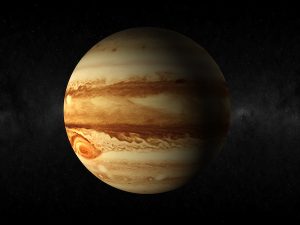Jupiter may be one of the most recognizable sights in the night sky, but it still manages to surprise not only everyday people, but also the scientists that continue to study it.
The Juno spacecraft successfully entered the orbit of Jupiter on July 4, 2016. In early 2018, it was able to get a glimpse of what goes on below the dense cover of clouds to answer questions about the gas giant and the origins of our solar system.
Juno’s primary goal is to reveal the story of Jupiter’s formation and evolution. Using long-proven technologies on a spinning spacecraft placed in an elliptical polar orbit, Juno will observe Jupiter’s gravity and magnetic fields, atmospheric dynamics and composition, and evolution.
Because Jupiter is so big, it has been influential in the story of the solar system. We can’t understand the origin of the solar system – and how Earth came about – without understanding how Jupiter formed. There’s still a lot we don’t know about Jupiter: what is it made of? What lies beneath those beautiful, swirling clouds? What exactly drives its magnetic field? Juno’s study of Jupiter will help us to understand the history of our own solar system and provide new insight into how planetary systems form and develop in our galaxy and beyond.
As the Juno probe orbits around this gaseous giant, new sides of the planet are being seen, answering some questions, yet raising others. One of the more recent findings came from the European Geosciences Union General Assembly in Vienna, Austria, where the researchers showed off the twisty patterns of the north pole, the latest on Jupiter’s interior and the first ever view of another planet’s magnetic field generator.
The most dramatic findings may be Juno’s views of the north pole of Jupiter. Because it used infrared light, which plows through dust and other impediments to visible light, the probe’s data gave researchers an unprecedented and penetrating view — up to 45 miles below the planet’s clouds. A spectacular and violent scene awaited them: a host of cyclones, 2500 to 2900 miles across, centered on the pole.
Designing precision lenses for infrared cameras is one of our specialties. They are used in a number of thermal imaging applications. They can be made with the sensitivity to capture short-wave, mid- and long-wave spectral bands. The benefit of being able to choose a specific spectral band for the infrared camera is that, depending on the item being observed, the spectral band allows for laser beam viewing.
NASA has now funded Juno through 2022. The end of prime operations is now expected in July 2021, with data analysis and mission close-out activities continuing into 2022.
“With these funds, not only can the Juno team continue to answer long-standing questions about Jupiter that first fueled this exciting mission, but they’ll also investigate new scientific puzzles motivated by their discoveries thus far,” said Thomas Zurbuchen, associate administrator for NASA’s Science Mission Directorate in Washington. “With every additional orbit, both scientists and citizen scientists will help unveil new surprises about this distant world.”
“This is great news for planetary exploration as well as for the Juno team,” said Scott Bolton, principal investigator of Juno, from the Southwest Research Institute in San Antonio. “These updated plans for Juno will allow it to complete its primary science goals. As a bonus, the larger orbits allow us to further explore the far reaches of the Jovian magnetosphere — the region of space dominated by Jupiter’s magnetic field — including the far magnetotail, the southern magnetosphere, and the magnetospheric boundary region called the magnetopause. We have also found Jupiter’s radiation environment in this orbit to be less extreme than expected, which has been beneficial to not only our spacecraft, but our instruments and the continued quality of science data collected.”
As Juno continues to orbit Jupiter, scientists an